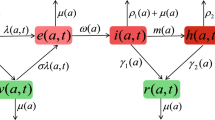Abstract
Cholera remains epidemic and endemic in the world, causing thousands of deaths annually in locations lacking adequate sanitation and water infrastructure. Yet, its dynamics are still not fully understood. In this paper, we simplify and improve Jensen et al.’s model (PNAS 103:4652–4657, 2006) by incorporating a Minimum Infection Dose (MID) into the incidence term. We perform local stability analysis and provide bifurcation diagrams of the bacterial carrying capacity with or without shedding. Choosing parameters such that the endemic or epidemic equilibrium is unstable (as it is the case in reality), we observe numerically that for the bacterial carrying capacity (K) less than the MID (c), oscillating trajectories exist only in the microbial scale, whereas for \(K>c\), they exist in both the microbial and population scales. In both cases, increasing pathogen shed rate \(\xi \) increases the amplitude of the trajectories and the period of the trajectories for those that are periodic. Our findings highlight the importance of the relationship among the shedding rates, K, MID, the maximum bacterial growth rate (r) and the features of the disease outbreak. In addition, we identified a region in the parameter space of our model that leads to chaotic behaviour. This could be used to explain the irregularity in the seasonal patterns of outbreaks amongst different countries, especially if the positive relationship between bacterial proliferation and temperature is considered.











Similar content being viewed by others
References
Asheshov I, Lahiri MN (1931) The treatment of cholera with bacteriophage. Ind Med Gaz 66:179–184
Baker RM, Singleton FL, Hood MA (1983) Effects of nutrient deprivation on Vibrio cholerae. Appl Environ Microbiol 46:930–940
Capasso V, Paveri-Fontana SL (1979) A mathematical model for the 1973 cholera epidemic in the European Mediterranean region. Rev Epidemiol Sante Publique 27:121–132
Cash RA, Music SI, Libonati JP, Snyder MJ, Wenzel RP, Hornick RB (1974) Response of man to infection with Vibrio cholerae. I. Clinical, serologic, and bacteriologic responses to a known inoculum. J Infect Dis 129:45–52
Codeço CT (2001) Endemic and epidemic dynamics of cholera: the role of the aquatic reservoir. BMC Infect Dis 1:1
Colwell RR, Brayton P, Herrington D, Tall B, Huq A, Levine MM (1996) Viable but non-culturable Vibrio cholerae O1 revert to a cultivable state in the human intestine. World J Microbiol Biotechnol 12:28–31
Davis W (2012) Unpublished Master’s thesis. University of Alberta, pp 49–95
Emch M, Feldacker C, Islam MS, Ali M (2008) Seasonality of cholera from 1974 to 2005: a review of global patterns. Int J Health Geogr 7:31
Faruque SM, INaser B, Islam MJ, Faruque ASG, Ghosh AN (2005) Seasonal epidemics of cholera inversely correlate with the prevalence of environmental cholera phages. PNAS 102:1702–1707
Hartley DM, Morris JG, Jr Smith DL (2006) Hyperinfectivity: a critical element in the ability of V. cholerae to cause epidemics. PLoS Med 3:e7
Islam MS, Drasar BS, Sack B (1994) Probable role of blue-green algae in maintaining endemicity and seasonality of cholera in Bangladesh: a hypothesis. J Diarrhoeal Dis Res 12:245–256
Jensen MA, Faruque SM, Mekalanos JJ, Levin BR (2006) Modeling the role of bacteriophage in the control of cholera outbreaks. PNAS 103:4652–4657
Joh RI, Wang H, Weiss H, Weitz JS (2009) Dynamics of Indirectly Transmitted Infectious Diseases with Immunological Threshold. Bull Math Bio. 71:845–862
McCluskey CC, van den Driessche P (2004) Global analysis of two tuberculosis models. J Dyn Diff Equ 16:139–166
Mukandavire Z, Liao S, Wang J, Gaff H, Smith DL, Jr Morris JG (2011) Estimating the reproductive numbers for the 2008–2009 cholera outbreaks in Zimbabwe. PNAS 108:8767–8772
Murphy KM, Travers P, Walport M (2007) Janeways immunobiology, Seventh ed. Garland Science, New York
Pasricha CL, de Monte AJH, OFlynn EG (1936) Bacteriophage in the treatment of cholera. Ind Med Gaz 71:61–68
Singleton FL, Atwell RW, Jangi MS, Colwell RR (1982) Effects of temperature and salinity on Vibrio cholerae growth. Appl Environ Microbiol 44:1047–1058
Snow J (1985) On the mode of communication of cholera. John Churchill, London
Tian JP, Wang J (2011) Global stability for cholera epidemic models. Math Biosci 232:31–41
Acknowledgments
We would like to acknowledge the support from NSERC Discovery Grant RES0001528. We also would like to thank Michael Li for the initial discussion.
Author information
Authors and Affiliations
Corresponding author
Rights and permissions
About this article
Cite this article
Kong, J.D., Davis, W. & Wang, H. Dynamics of a Cholera Transmission Model with Immunological Threshold and Natural Phage Control in Reservoir. Bull Math Biol 76, 2025–2051 (2014). https://doi.org/10.1007/s11538-014-9996-9
Received:
Accepted:
Published:
Issue Date:
DOI: https://doi.org/10.1007/s11538-014-9996-9




